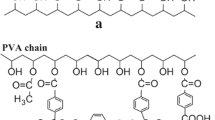Abstract
The influences of zinc dimethacrylate (ZDMA) contents and three different sulfur systems, i.e. conventional, semi-efficient, and efficient vulcanisations or CV, semi-EV and EV, respectively on crosslink densities and comparative properties of styrene-butadiene rubber compounds containing a fixed amount of peroxide used as an additional crosslinkerwere investigated. The results of cure characteristics and total/specific crosslink densities in different linkage types clearly confirm that, besides synergistic effect of ZDMA towards improved peroxide cure, the extraordinary ionic crosslinks can be generated by this substance, leading to considerable rises in modulus and strength of vulcanisate. However, its ionic-crosslinking efficiency is potentially lessened with increasing sulfur proportion. Elasticity indicated by loss tangent and heat build-up of vulcanisate increases with increasing ZDMA contents due to a higher total crosslink density. The overall properties of CV-based compounds have shown to be independent on ZDMA loading levels. Semi-EV and EV systems provide superior thermal ageing resistance to the vulcanisate compared to CV system due to a greater proportion of short crosslinking bonds: mono-/disulfidic, and carbon-carbon linkages, in EV and semi-EV cured stocks. In addition, the increment of ZDMA contents appears to improve heat-ageing properties of the vulcanisate, attributed to a better thermal stability of ionic crosslinks.
Similar content being viewed by others
References
HOFMANN, W. (1989) Rubber Chemicals and Additives. In: Rubber Technology Handbook. New York: Carl Hanser
RADER, C.P. (2001) Vulcanisation of Rubber - A. Sulfur and Non-Peroxides. In: Basic Elastomer Technology. Baranwal, K.C. and Stephens, H.L. (ed.) Ohio: Rubber Division, American Chemical Society.
MORI, M. (2003) Study of Vulcanisation and Degradation Chemistry in Natural Rubber by Solid-State 13C NMR and Physical Property Measurements. Rubber Chem. Technol., 76(5), 1259–1275.
CHEN, C.H., KOENIG, J.L., SHELTON, J.R. AND COLLINS, E.A. (1981) Characterization of the Reversion Process in Accelerated Sulfur Curing of Natural Rubber. Rubber Chem. Technol., 54(4), 734–750.
SHANKAR, U. (1952) Investigations of the Reversion of Vulcanisate Rubber under Heat. Rubber Chem. Technol., 25(2), 241–250.
AKIBA, M. AND HASHIM, A.S. (1997) Vulcanisation and Crosslinking in Elastomers. Prog. Polym. Sci., 22(3), 475–521.
BRODSKY, G.I. (1994) Mixed Peroxide-Sulfur Rubber Curing System. Rubber World, 210(5), 31–39.
VANBEVERVOORDE-MEILOF, E.E., VAN HAERINGEN-TRIFONOVA, D., VANCSO, G.J., DOES VAN DER, L., BANTJES, A. AND NOORDERMEER, J.W.M. (2000) Cross-link Clusters: Reality or Fiction? Kautch. Gummi Kunstst., 53(7/8). 426–432.
HENNING, S.K. AND COSTIN, R. (2006) Fundamentals of Curing Elastomers with Peroxides and Coagents. Rubber World, 233, 28–35.
FLORY, P.J. (1950) Statistical Mechanics of Swelling of Network Structures. J. Chem. Phys., 18(1), 108–111.
GEORGE, S.C., NINAN, K.N. AND THOMAS, S. (1999) Effect of Degree of Crosslinking on Swelling and Mechanical Behavior of Conventionally Vulcanisate Styrene-Butadiene Rubber Membranes. Polym. Polym. Compos., 7, 343–353.
SAVILLE, B. AND WATSON, A.A. (1967) Structural Characterization of Sulfur-Vulcanisate Rubber Networks. Rubber Chem. Technol., 40(1), 100–148.
NIE, Y., HUANG, G., QU, L., ZHANG, P., WENG, G. AND WU, J. (2010) Cure Kinetics and Morphology of Natural Rubber Reinforced by the In Situ Polymerisation of Zinc Dimethacrylate. J. Appl. Polym. Sci., 115(1), 99–106.
ZHAO, J., GHEBREMESKEL, G.N., PEASELY, J. AND NECHES, P. (2001) Properties of EPDM/SBR Blends Cured with Peroxide and Sulfur Coagent. Kautch. Gummi Kunstst., 54(5), 223–228.
LOAN, L.D. (1971) Chemical Transformations of Polymers: Peroxide Crosslinking Reactions of Polymers. Rado, R. (ed.) Bratislava: International Union of Pure and Applied Chemistry (TUPAC).
CLASS, J.B. AND DLUZNESKI, P.R. (2001) Basic Elastomer Technology: Vulcanisation of Rubber - B. Peroxides. Baranwal, K.C. and Stephens, H.L. (eds.) Ohio: Rubber Division, American Chemical Society.
BAIN, P.J.S. AND DIBBO, A. (1968) Delayed Action Acceleration for Vulcanisation of Rubber. US Patent: 3406141, UK.
FUJIO, R., KITAYAMA, M., KATAOKA, N. ANDANZAI, S. (1979) Effectsof Sulfur on the Peroxide Cure of EPDM and Divinylbenzene Compounds. Rubber Chem. Technol., 52(1), 74–83.
HALL, D.E. AND MORELAND, J.C. (2000) Fundamentals of Rolling Resistance. Proceedings of the American Chemical Society - Rubber Division Conference, Dallas, TX.
PALYS, L.H. AND CALLAIS, P.A. (2003) Understanding Organic Peroxides to Obtain Optimal Crosslinking Performance. Rubber World, 229(3), 35–41.
MCELWEE, C.B. AND LOHR, J.E. (2001) Comparing Curing Systems: Peroxide-Coagent versus Sulphur-Accelerator in Polyisoprene. Rubber World, 225, 41–44.
MCELWEE, C.B. AND BURKE, J.S. (2003) Use of Coagents for Adhesive and Dynamic Property Improvements in Peroxide-cured IR. Rubber World, 228, 36–41.
BATEMAN, L. (1963) The Chemistry and Physics of Rubber-Like Substances. London: MacLaren Press.
Author information
Authors and Affiliations
Corresponding authors
Rights and permissions
About this article
Cite this article
Naebpetch, W., Nithi-Uthai, N., Saetung, A. et al. Utilisation of Zinc Dimethacrylate as Coagent in Sulfur-Peroxide Dual Vulcanisation with Different Sulfur Systems for Styrene-Butadiene Rubber Compounds. J Rubber Res 20, 71–86 (2017). https://doi.org/10.1007/BF03449143
Received:
Accepted:
Published:
Issue Date:
DOI: https://doi.org/10.1007/BF03449143




